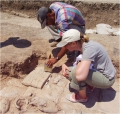By Owen Jarus, 15 October 2010
Archaeologists excavating a 2,700 year old temple at the ancient city of Tayinat, in southeastern Turkey, have discovered evidence that its inhabitants prominently displayed a tablet which bore a pledge of loyalty to the heir of an Assyrian king.
The city of Tayinat was built on the Amuq plain, on the Orontes River near the modern day Syrian border. The Assyrian Empire conquered it in 738 BC, with a governor being appointed to oversee it. The city's temple is about 12 meters by six meters in size, and pre-dates the conquest. The excavations at Tayinat are led by Professor Tim Harrison of the University of Toronto.
The discovery of the tablets adds new insight into how the Assyrians controlled Tayinat. Using careful field recording and textual analysis the team discovered that it was elevated on a platform in the temple’s cella, a part of the building also known as the “holy of holies.”
The oath declares that the city’s governor, and possibly other citizens, would recognize Ashurbanipal as the heir to the throne of the Assyrian Empire, after his father’s (king Esarhaddon's) death. Nearly identical oaths have been found at the site of Nimrud in modern day Iraq.
“You shall protect him in country and in town, fall and die for him. You shall speak with him in the truth of your heart, give him sound advice loyally, and smooth his way in every respect,” the oaths read. A long list of curses is cast upon anyone who breaks the oath.
“May Sin, the brightness of heaven and earth, clothe you with leprosy and forbid your entering into the presence of the gods or king. Roam the desert like the wild-ass and the gazelle,” one of the curses reads. “May Mullissu, who dwells in Nineveh, tie a flaming sword at your side,” says another.
“The presence of the oath tablet at Tayinat affirms Ashurbanipal’s claim that his father caused all the people of Assyria, great and small, to take the oath,” said team epigrapher Professor Jacob Lauinger of John Hopkins University.
It appears to have been created on the 18th day of the 2nd month of the year 672 BC. “The (Tayinat) tablet was written most likely on the same day as the tablets from Nimrud,” said Professor Lauinger.
The next puzzle for the team to crack is why the loyalty oath was placed in such a prominent position. Was it a sort of votive offering? Or was it an object of religious veneration? “The prospects are tantalizing,” said Lauinger, “but of course we have a good deal of work to do first.”

